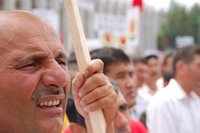Last Saturday, May 27th, I observed a political demonstration in the central Ala-Too Square (named after the majestic 4000+meter Ala-Too mountain range looming over the city to the south (Ala-Too means colorful mountains)). The demonstration was organized by the main opposition parties to the current governing party run by President Bakiev and Prime Minister Kulov, who came to power after the March 24th "Tulip" Revolution of 2005. The revolution ousted the former President Akayev, whose initially democratic and reform-minded tenure in office, which began following the collapse of the Soviet Union, soon became very corrupt. Akayev used his power to enrich his family and cronies, and even siphoned off all of the 'rent money' paid by the Pentagon for the use of the nearby Manas air base by the U.S. Air Force, including the jet fuel revenues which he sold at triple the market rate. Thank your senators for that fine waste of U.S. taxpayer money. Sick of their corrupt government, reform-minded activists and other political opportunities took to the streets, starting in the southern cities like Osh, and soon the streets of Bishkek boiled over with revolution. Akayev and many of his cronies were chased out of the Kyrgyz "White House" and out of the country, with few casualties fortunately, but quite a bit of looting of businesses perceived to be owned by Akayev's family. Internationally monitored elections brought a new regime to power with high hopes for real democratic and economic reforms, elimination of endemic corruption, and a crackdown on rising ethnic mafias that operate in different regions of the country. So it goes in the Who's ode to revolution, Won't Get Fooled Again, "Meet the new boss, same as the old boss." So it goes in Kyrgyzstan. Newly-elected President Bakiev's government has been achingly slow to implement much needed reforms, and indeed seems to be taking over Akayev's corruption racket quite handily. Bakiev's son now owns a monopoly cement enterprise, and Bakiev has links to some very shady criminal figures, including the recently murdered Kyrgyz crime boss Ryspek Atkembaev, who was living under Presidential protection at Bakiev's retreat at Lake Issyk Kul. It was a professional hit in broad daylight in front of a mosque near Bishkek. Rumors of suspects and motives have been swirling around freely in the central asian conspiracy vortex, but most are certain the real answer will not be found, just as investigations into the deaths of several parliamentarians last year have been stifled by the government. Amidst this political chaos, there is still some hope. There is a free press, though Bakiev has been threatening to shut down the main indepedent media company, Pyramid Media. And there is an organized opposition and well-established civil society as well. And most people I've spoken with do not trust this president more than the last one and ardently wish for change, but as well most people just want to make a better living than what's available now. The gap between the wealthy elite and the rest of the country is quite stark, and Kyrgyzstan does not share the same natural resource wealth (i.e. oil and gas) that is greatly improving the lives of their Kazakh cousins to the north, who don't enjoy nearly as many political freedoms as the Kyrgyz.
So as the first anniversary of the Tulip Revolution came and went with few discernable changes, it is easy to understand why apathy toward politics has begun to spread. Despite this, tens of thousands have come out in support of the "For Reform" opposition rallies on April 29th and May 27th of this year. Fears of violence by agitators trying to hurt the image of the movement and provoke harsh responses by government forces never materialized at either event. Instead they were quite festive events, with the usual blustery political speeches, along with some entertaining songs, poetry and prose mocking the current administration. As well there was a large diversity of supporters, young and old, earnest university activists and concerned world war II veterans. Finally a list of demands for the government was announced at the end of the rally, which can be viewed here .
I met a young lawyer from the Justice Department whose uncle was a parliamentarian and guest speaker at the rally. He spent time studying in the United States and expressed awe and respect for the American judicial and political system. Flawed as it is at times, he knew it was something his country should strive to achieve. I asked him if he thought the rally that day was a success and he said, "Maybe. We cannot have more demonstrations with no results. The people will become frustrated, and maybe again, they will march on the White House..."

A Kyrgyz armored vehicle parked in Ala-too Square. The Kyrgyz government tried to block the opposition rally on the square by proclaiming the same day the Army and National Guard Day Parade will be held, though the holidays were actually several days later. Fortunately, the government relented and allowed the rally instead.

Reform supporters... with cool shades...


A sign on a port-o-let asking President Bakiev's son Max, 'what about cement for the people!"

Never too early for civic education in Central Asia!

The local free press getting into the action.

A young journalist with Pyramid Media getting the message from the people.

"No Room for Max!" the President's son suffers at the hands of another slogan...


It was hot, but not too hot to keep the oldtimers away from cheering on democracy.


The wide view of Ala-Too Square, with the Erkindik (Freedom in Kyrgyz) statue and the National Museum providing the backdrop.

More pensioners out in support of democratic reform. Some wore their military medals. The traditional hat they wear is called a kalpak.
More photos of the rally here...







